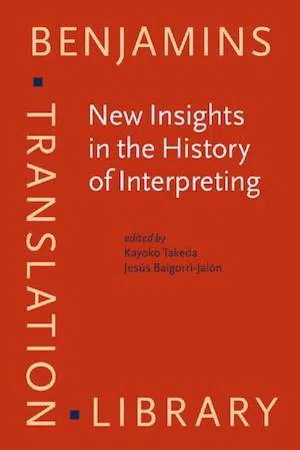
- English
- PDF
- Available on iOS & Android
New Insights in the History of Interpreting :
About this book
Who mediated intercultural exchanges in 9th-century East Asia or in early voyages to the Americas? Did the Soviets or the Americans invent simultaneous interpreting equipment? How did the US government train its first Chinese interpreters? Bringing together papers from an international symposium held at Rikkyo University in 2014 along with two select pieces, this volume pursues such questions in an exploration of the practice of interpreting, the recruitment of interpreters, and the challenges interpreters have faced in diplomacy, colonization, religion, war, and occupation. It also introduces innovative use of photography, artifacts, personal journals, and fiction as tools for the historical study of interpreters and interpreting. Targeted at practitioners, scholars, and students of interpreting, translation, and history, the new insights presented aim to spark discussion and research on the vital roles interpreters have played in intercultural communication through history.
Frequently asked questions
- Essential is ideal for learners and professionals who enjoy exploring a wide range of subjects. Access the Essential Library with 800,000+ trusted titles and best-sellers across business, personal growth, and the humanities. Includes unlimited reading time and Standard Read Aloud voice.
- Complete: Perfect for advanced learners and researchers needing full, unrestricted access. Unlock 1.4M+ books across hundreds of subjects, including academic and specialized titles. The Complete Plan also includes advanced features like Premium Read Aloud and Research Assistant.
Please note we cannot support devices running on iOS 13 and Android 7 or earlier. Learn more about using the app.
Information
Table of contents
- Introduction
- Chapter 1. Defining Sillan interpreters in first-millennium East Asian exchanges
- Chapter 2. Interpreting practices in the Age of Discovery: The early stages of the Spanish empire in the Americas
- Chapter 3. Interpreting for the Inquisition
- Chapter 4. Nagasaki Tsūji in historical novels by Yoshimura Akira: An alternative way of studying the history of interpreters
- Chapter 5. The U.S. Department of State’s Corps of Student Interpreters: A precursor to the diplomatic interpreting of today?
- Chapter 6. At the dawn of simultaneous interpreting in the USSR: Filling some gaps in history
- Chapter 7. The use of photographs as historical sources, a case study: Early simultaneous interpreting at the United Nations
- Chapter 8. “Crime” of interpreting: Taiwanese interpreters as war criminals of World War II
- Chapter 9. Guilt, survival, opportunities and stigma: Japanese interpreters in the post-war occupation period (1945–1952)
- Chapter 10. Risk analysis as a heuristic tool in the historiography of interpreters: For an understanding of worst practices
- Name index
- Subject index